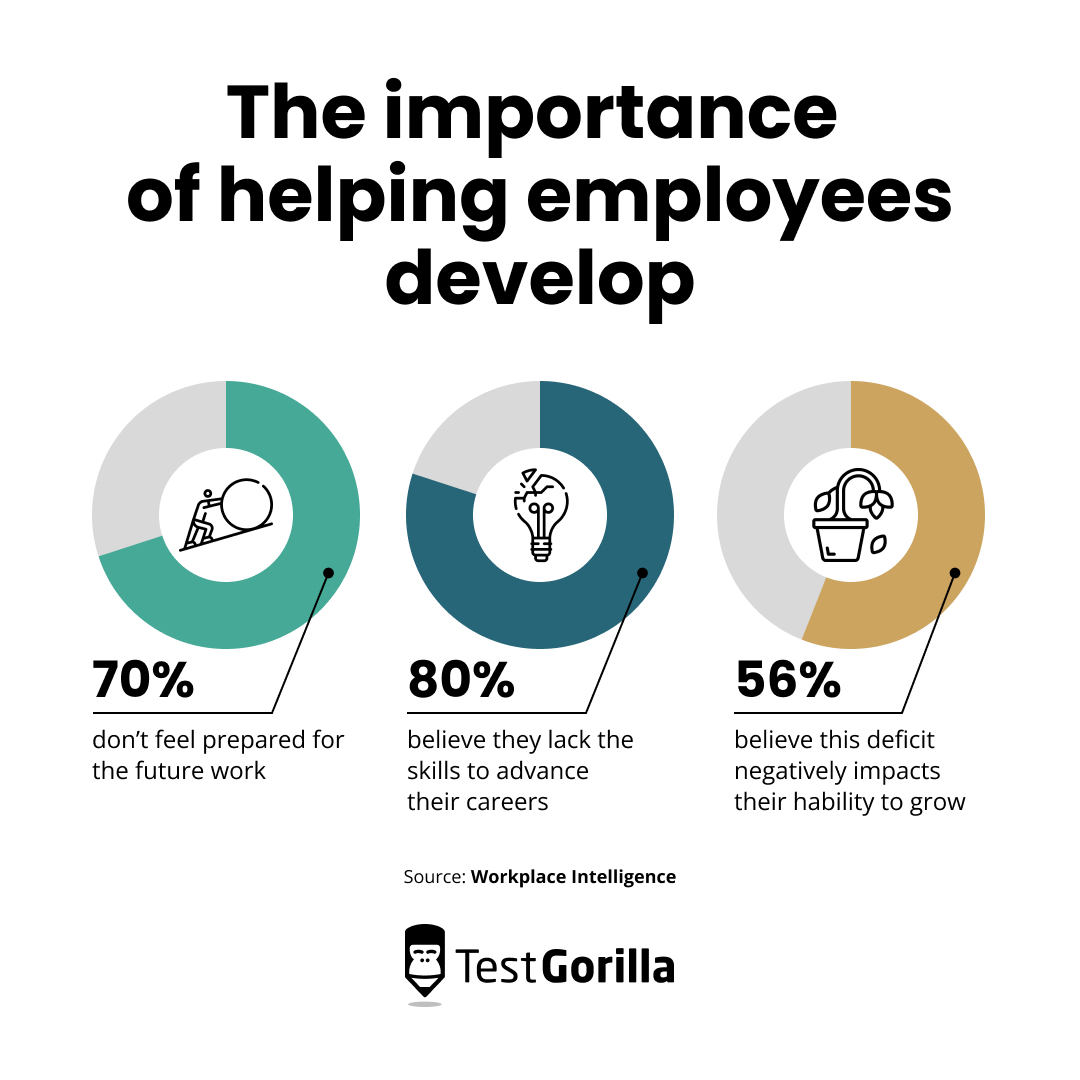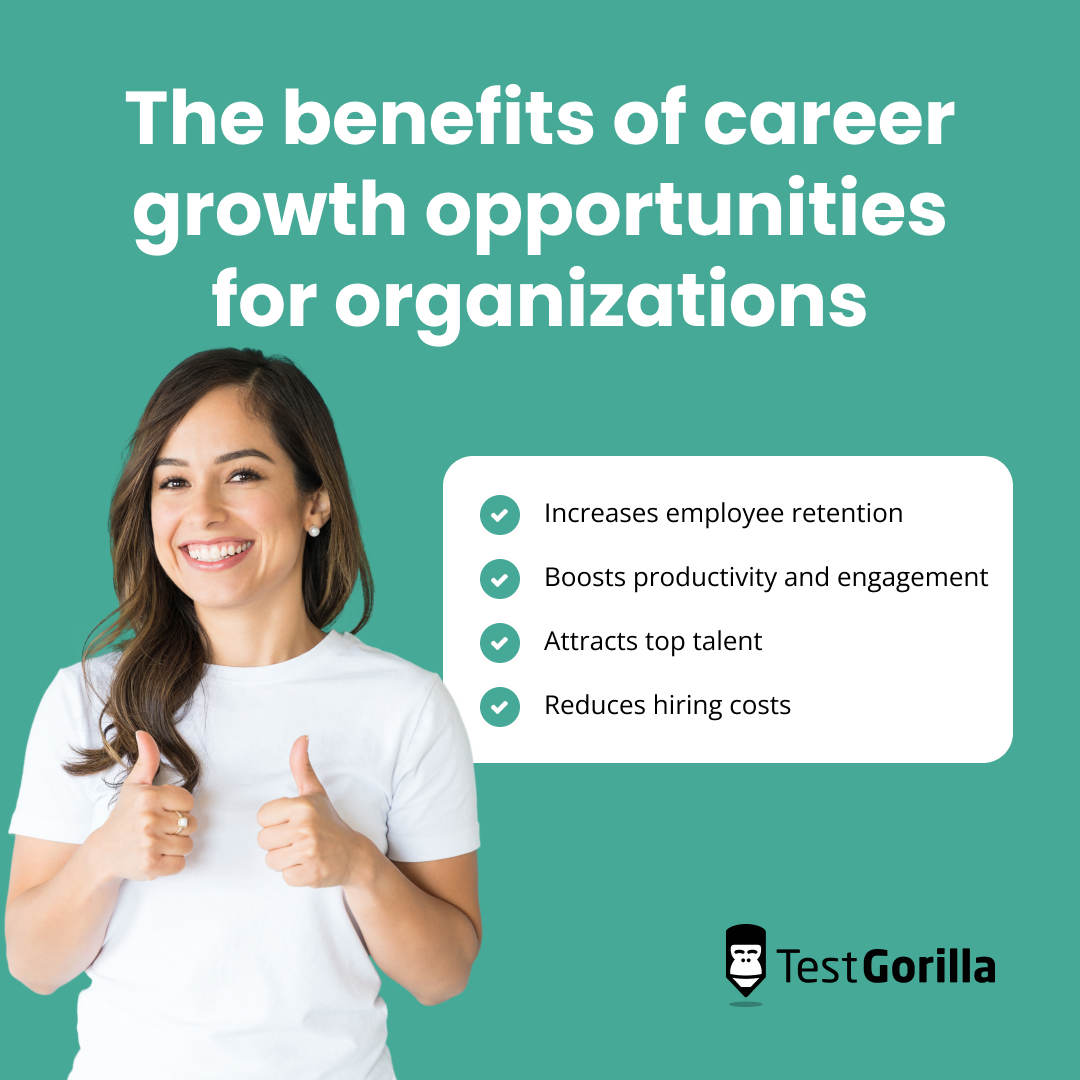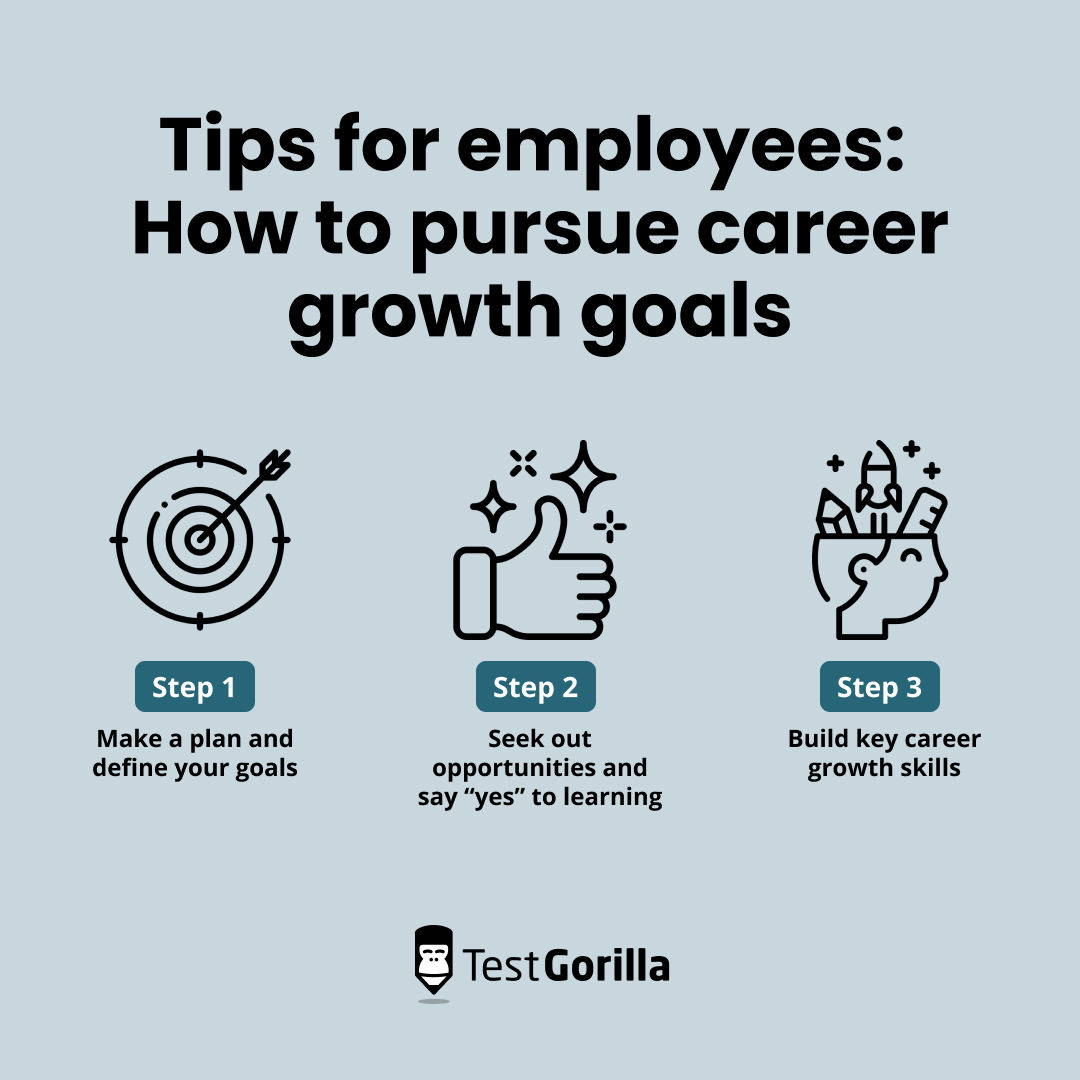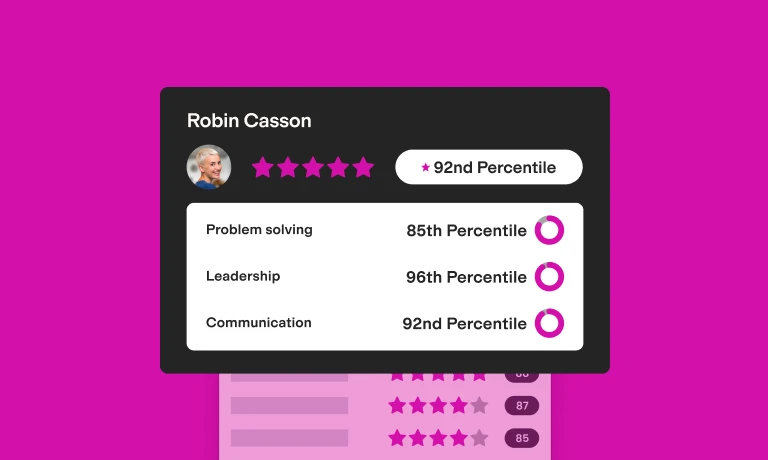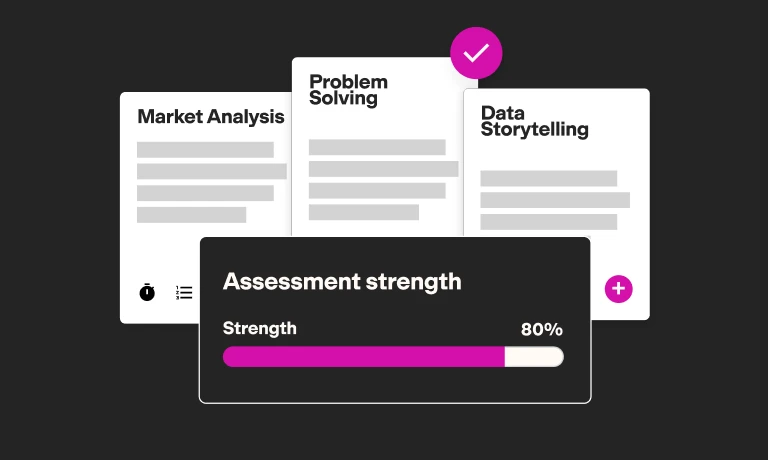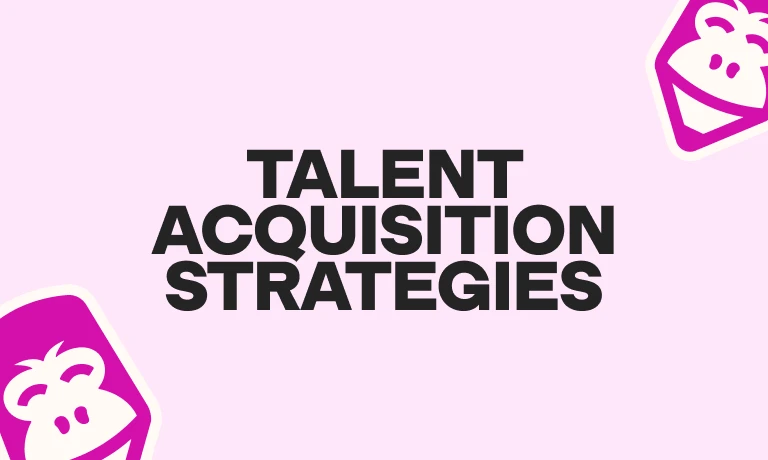Career growth: Leverage this retention strategy and help your team achieve its goals
Professional goals mean a lot to workers. They aren’t just a matter of compensation. They are about aspiring for something great and achieving it.
Career growth is essential to your employees – 83% of employees say that improving their skills is a top priority, and 88% are putting a significant amount of time and effort towards it. A further 64% are likely to quit because of a lack of development opportunities.[1]
This effort must be collaborative.
Employees want to put time and effort into growth; if their employer doesn’t help, they often leave to find one that does.
Encouraging career growth is a top employee retention strategy. When companies support professional development, it makes people feel valued, increases engagement, and aligns their motivation with the organization’s purpose.
This blog post explains how supporting career growth and development attracts and retains top talent. It also provides best practices to encourage this growth from the perspectives of the employees and the employers.
Table of contents
- What is career growth?
- Why is professional growth important?
- The benefits of career growth and development for organizations
- 7 best practices for leveraging career growth to retain your best performers
- The benefits of career growth opportunities for employees
- 3 tips for employees: How to pursue career growth goals
- 3 examples of companies succeeding with career growth and development as a talent retention strategy
- Facilitate employee career growth with talent assessments
What is career growth?
Career growth is the journey to a person’s ideal job and the steps they must take to achieve it.
It's generally a role progression from junior to senior, but it can also describe a long-term process of trying to achieve your ultimate professional goals. These goals could include a specific job title, salary, or completing a particular project.
Career growth goes hand in hand with certain employee retention trends.
For example, leveraging employee listening lets you hear your team’s goals in-depth, making a career growth plan accurate and successful. It also increases your workforce’s job satisfaction and wellbeing.
The difference between career growth and development
Employee career growth and career development are sometimes used interchangeably, but the two have distinct meanings.
The short answer is that career growth is the entire journey to reach your professional growth goals. Career development refers to the individual activities that help you along the way in your professional life.
Here’s a quick summary:
Career growth | Career development |
- A long-term vision or goal for your career path - The entire journey of your career from start to finish - A particular project or target salary you hope to achieve | - The short-term and long-term activities needed to reach your end goal - The tangible steps to build hard and soft skills and increase responsibilities - Many smaller points employees add to a career growth plan |
Career development is a crucial part of career growth. Little bits of development build up into the entire journey that encompasses your complete professional growth.
Why is professional growth important?
Employees desire professional growth, which is essential for their continued productivity and performance.
More than 65% of people don’t feel prepared for the future of work, nearly 80% believe they lack the skills to advance their careers, and 56% believe this deficit negatively impacts their ability to grow professionally.[1]
If employees don’t receive support to fulfill this need, they look for a new place to work. Encouraging and supporting employee career development plans directly affects your employee turnover rate.
Nearly 90% of job seekers say that a strong development program is critical when searching for a new role, and 76% of employees agree they’re more likely to stay with a company that provides continuous training.[1]
Every employee wants to grow professionally, and many need to grow to stay relevant in a shifting landscape.
They have goals and aspirations, and you become an attractive employer – one people want to stay with for years – when you help them achieve these objectives.
It shows your team it’s valued and you're willing to invest in its future.
Here are a few reasons why nurturing employee career development is important for employers:
Builds a great corporate reputation and employer branding: A company that helps its people grow and prepare for the future attracts top talent. It also helps build a positive reputation.
Helps you create an agile workforce: Helping your people develop and build more skills increases overall adaptability and agility.
Encourages more engagement and motivation: Showing your employees that you care about their goals and aspirations aligns their motivation with their work, promoting engagement.
Fosters internal mobility: Helping your team grow and pursue new roles nurtures a culture of internal mobility, which reduces external hiring costs and boosts employee loyalty.
Career growth opportunities are an expected employee benefit and provide people with security and confidence.
Here’s why career growth is important to employees:
Helps them achieve more professionally and supports their aspirations
Enables them to build new skills through certifications and leadership development
Gives them a sense of purpose
Secures their career journey and contributes to personal growth
In the next sections, we discuss the benefits of career growth in detail and provide best practices to nurture it in your workforce.
First, we cover the benefits and tips for employers, and then we discuss the same from the employees’ side.
The best insights on HR and recruitment, delivered to your inbox.
Biweekly updates. No spam. Unsubscribe any time.
The benefits of career growth and development for organizations
Organizations that provide career growth opportunities build a positive atmosphere where employees want to work, increasing retention and engagement.
There are huge advantages to supporting employee career development plans. Let’s take a look at the main ones.
1. Increases employee retention
Your workforce craves professional growth. Each employee has goals they aspire to achieve, and if their employer doesn’t support them, they can find a company that does.
Job stagnation is directly related to employee turnover.
Each additional 10 months an employee spends in the same job role correlates to a one percent increase in the likelihood of them finding a new job, even after controlling for factors like salary, culture, industry, and job title.[2]
However, enabling employees to explore opportunities within your organization has an excellent effect on your employee retention rate. People who work at companies with high internal mobility stay 60% longer than those who don’t have this option.[3]
2. Boosts productivity and engagement
Learning and development boost employee engagement. Learning new skills and being challenged help excite and motivate employees.
Employees who move into new internal roles are 3.5 times more likely to be engaged.[4]
Further, helping employees grow into their ideal job roles helps increase their productivity.[5]
Supporting career growth goals engages employees by connecting them to their work. When workers know their company cares about their future, their motivation increases.
Career growth programs also make workers more connected to their work because they’re witnessing real progress and fighting stagnation.
3. Attracts top talent
Building a career growth plan is important to employees because they want to be sure of their future before they commit to a new company.
If employees don’t see a long future with your company, they decline your offer: 65% of workers believe that employer-provided development opportunities are very important when considering a job offer.
It’s especially important to the youngest generations of the workforce. Nearly three-quarters of millennial and Gen Z workers are likely to leave their jobs because of a lack of growth opportunities.[1]
A huge portion of the modern workforce is seeking learning opportunities, and you could be the company they’re looking for.
4. Reduces hiring costs
External hiring, although common, can be an expensive way to fill an open role.
The average cost per hire is around $4,700, but many employers estimate that the total is nearly three to four times the position’s salary.
A job position that pays $50,000 could cost more than $150,000 to fill, including additional costs such as job boards and the opportunity cost of time of leaders and managers who assist the process.
However, facilitating professional growth is much more affordable – 79% of development professionals agree that reskilling a current employee into a new position is less expensive than hiring externally.[6]
Internal hires don’t have many fees associated with hiring, such as recruiter costs, and they also onboard faster.
7 best practices for leveraging career growth to retain your best performers
Encouraging and supporting career progression is a must, but it’s hard without the right tactics.
Here are our seven top strategies to leverage professional growth, including building career growth plan templates and fostering a culture of internal mobility.
Strategies to encourage career growth: A summary
Strategy | What it accomplishes |
1. Encourage internal mobility | Creates an environment where supporting career growth and development is natural and expected |
2. Ensure employee goals align with business objectives | Motivates employees with goals that engage them |
3. Provide employees with growth opportunities and encourage them to leverage them | Empowers employees to take their growth into their own hands and use a variety of training methods |
4. Take a personal interest in career growth | Shows your workforce that you support them |
5. Monitor growth using talent assessments | Gives you objective data to accurately inform growth plans |
6. Encourage upskilling and reskilling | Enables you to leverage different plans for unique goals |
7. Start a mentorship program | Lets junior employees benefit from development, and senior employees share their knowledge |
1. Encourage internal mobility
It’s easier to encourage career growth when it’s a normal part of your culture. It also becomes a part of your reputation and employer branding.
Building a culture of internal mobility and career progression becomes the norm rather than the exception.
Here are a few ways to do it:
Encourage talent sharing
Adopt a skills-based mindset, leaning away from traditional, rigid job roles
Promote from within wherever possible
Adopt learning as a core value
Leverage an internal talent marketplace
An internal talent marketplace is a great way to support many types of career growth. This central platform enables employees to list their skills and goals and get matched with relevant opportunities.
It empowers employees to seek out their own career growth opportunities and helps HR professionals match projects and gigs to interested candidates.
For more information, read our full guide on how to build an internal talent marketplace.
2. Ensure employee goals align with business objectives
You must consider your employees’ goals and aspirations – people don’t have the motivation to follow through with plans unless they want to pursue a role.
For example, an employee with no interest in a management role has been with a company long enough that it’s “about time” they moved up.
This employee does have career aspirations, but they have different types of career growth in mind, such as a higher-paid individual contributor or a subject matter expert.
However, it’s important that their goals still align with your business objectives. Keeping a subject matter expert on staff could be a drain on your company’s resources if they don’t serve an organizational goal.
If there’s a drastic difference between employee and employer goals, you can explore other paths with them and try to find a middle ground.
Doug Dennerline, the chief executive of Betterworks, says you can usually resolve this issue through communication. If you hit a particularly difficult roadblock, you should take your time and try to work things out with the employee.[7]
In our above example, this could look like the employee staying on as an individual contributor who takes higher-paid projects quarterly.
Ultimately, the alignment may not be perfect, but you can work it out and grow stronger.
3. Provide employees with growth opportunities and encourage them to leverage them
If you want employees to develop, you must provide them with various opportunities and actively encourage workers to use them.
A wide variety of employee training programs ensures that everyone learns how they want and need to learn.
For example, offering in-person and online courses ensures flexible workers can pursue professional growth.
You must also make your entire workforce aware of these opportunities. Create a centralized location to keep all your resources where employees can review and apply for them.
Using a centralized location puts the ball in their court. Career growth must be collaborative – you provide opportunities and empower employees to act on them.
4. Take a personal interest in career growth
Employee career growth is largely up to the workers, but their employer must be involved.
Globally, only three in ten employees strongly agree that someone at work encourages their development.[8]
Offering tangible resources is important, but showing your mental and emotional support is just as critical.
Here are a few ways to show your human resources that you care about their career progression:
Actively promote career planning and growth and get involved
Encourage managers to discuss growth with employees and check in on their progress
Promote employee coaching and feedback
Attend conferences or training sessions with employees and offer academic support
Share your experiences with junior team members
Help your team build professional development plans
Let’s discuss that last point quickly.
Professional development plans describe an employee’s career goals and the steps needed to achieve them. They also describe the resources available and the estimated time frame until an employee can accomplish this goal.
These career growth plan templates are a great way to motivate employees and help them visualize their professional growth.
5. Monitor growth using talent assessments
Measuring employee career development shows you if you’re on the right path and where you need small corrections.
However, most ways to measure progress, like asking colleagues or managers, are subjective.
However, measuring career progression with talent assessments gives you a solid, data-driven way to monitor growth.
You know when an employee is ready for the next stage and can pinpoint which area needs more development.
Here’s what that looks like in a TestGorilla skills test.
It gives you a clear picture of where each employee needs development and removes guesswork and gut feelings, leaving you with solid data.
You can then give constructive employee feedback and recommend resources to help the worker bridge this gap and move to the next level.
6. Encourage upskilling and reskilling
Upskilling and reskilling are excellent strategies for encouraging employee development.
Here’s a quick comparison of the two:
Upskilling: Helping employees build skills related to their current role so they can take advantage of lateral moves or enter leadership roles
Reskilling: Helping employees build skills unrelated to their current role so they can move into a brand-new position
Although upskilling is more common, both strategies are great ways to nurture development and help employees accomplish their goals.
You need many options to cater to unique employee wants and needs. There are many different types of career growth, so you need unique strategies to facilitate them all.
For example, if one sales representative wants to become an account executive, they would require upskilling. On the other hand, a customer service representative who wants to become a sales representative would require reskilling.
7. Start a mentorship program
A mentorship program encourages career growth and gives your company an active role in your people’s development.
Mentorship is a simple way to promote employee career development, even in small companies that can’t afford large upskilling initiatives.
It’s also an excellent strategy if your organization has great generational diversity.
Knowledge-sharing is one of the top benefits of a multigenerational workforce, and mentorship is the perfect way to leverage it.
Mentorship also benefits the mentor. For example, if one of your older employees wants to take advantage of your phased retirement plan, they can reduce their responsibilities and coach select teammates.
The benefits of career growth opportunities for employees
Unsurprisingly, achieving career growth goals is important to every employee. Focusing on professional growth enables people to pursue their passions, earn more money, and get closer to their dream jobs.
Here are a few of the top benefits for employees.
Benefit | Description |
Increases compensation | Improved employee compensation is one of the main reasons that employees pursue new roles. Other goals, like taking on ambitious projects, could come with a bonus. |
Reduces burnout | Often, burnout comes from stagnation or not having enough work to do. New challenges alleviate it. |
Improves overall satisfaction and happiness | Professional growth improves work and personal life. An impressive 90% of people believe how we feel at work impacts life outside work.[9] |
Improves work-life balance | Career progression leads to a healthier, more manageable employee work life balance. Nearly half of the workforce hopes that career advancement improves work-life balance.[1] |
Achieving these benefits is the ultimate goal, but building a career growth plan is a two-way street.
It requires effort from employers and employees alike.
Let’s talk about that next.
3 tips for employees: How to pursue career growth goals
When career growth is the responsibility of both parties, it’s a powerful retention strategy.
We’ve listed our best practices for employers, so let’s see what employees can do to boost their career progression.
Encourage your employees to adopt these tips to take their growth into their own hands – promote these tips personally during one on one meetings and more publicly in weekly huddles.
Here’s a quick summary of our tactics:
Make a plan and define your goals
Seek out opportunities and say “yes” to learning
Build key career growth skills
1. Make a plan and define your goals
Encourage employees to build a plan and determine their primary career goals – whatever they are. It shows employees that you’re thinking about their development but still leaving it in their hands.
This practice encourages employees to consider what’s important to them, not just a traditional career ladder.
Some companies put too much weight on upward growth, opting for an "up or out" strategy, which stresses out many employees or pushes them to move to other companies.
Career growth needs to match the employee’s goals, which may not be as ambitious as the ones you have planned.
When an employee determines their goals, it’s an opportunity for them to share upward feedback about where they want their career to go.
Enabling your workforce to freely determine their career objectives is an effective way to foster an inclusive culture.
2. Seek out opportunities and say "yes" to learning
Promote learning and encourage your workforce to embrace learning opportunities. It’s important to nurture a growth mindset, which naturally drives employees to pursue development.
Many employees shy away from new opportunities, even when they crave growth. It happens because challenges can be intimidating, and it’s often easier to stick to normal daily activities.
Employees also avoid new opportunities because many companies lack security and psychological safety, preventing them from seeing situations as learning opportunities.
As an HR professional, you must establish an environment where people feel secure so your workforce thinks of everything as a chance to improve.
For example, employees can’t frame mistakes as learning opportunities if an organization penalizes every mistake.
3. Build key career growth skills
Encourage your people to grow meta skills – abilities that help you build more skills. These capabilities are also transferable, meaning that they’re useful in multiple positions.
It greatly helps employee development to build crucial skills like:
Leadership
Teamwork
Learning agility
Curiosity
Adaptability
These skills are not only beneficial to many roles, they’re also desirable for the future of work. Many companies are prioritizing these human-specific skills to complement their AI strategies.
Promote the importance of building these skills in your workforce. People may devalue a few of these competencies because they aren’t the skills they seek in career growth.
For example, many employees see the value in building leadership skills, but some doubt the importance of learning agility.
3 examples of companies succeeding with career growth and development as a talent retention strategy
When companies collaborate with their workforces, professional growth is a powerful talent retention strategy.
These three organizations built solid plans to work with their employees and achieve successful growth.
Let’s take a look at these outstanding career growth examples.
Companies with excellent career growth strategies: A summary
Company | Why it’s successful |
Enterprise Mobility | Encourages an open-door policy where mentorship happens during informal and formal training sessions |
Northrop Grumman | Promotes building a wide range of skills and supports a diverse workforce |
Thoughtworks | Empowers employees to own their growth |
Enterprise Mobility
Enterprise Mobility, a mobility services company, has an excellent career growth culture, providing its employees with multiple resources and opportunities.
This company offers instructor-led training by subject matter experts and mentorship as its primary learning resources.
Enterprise Mobility encourages casual mentorship through an open-door policy and a formal mentorship program. This program focuses on professional and personal development, such as work-life balance.
This company encourages its workforce to get involved in their career growth. It rewards people who perform well, put dedicated effort into their roles, and actively ask leaders for advice.
Northrop Grumman
Northrop Grumman, an aerospace and defense technology company, values and promotes employee career development.
This business offers many programs for its workforce to expand its capabilities across various skill sets. It encourages people to grow professionally and reach their goals as they continue to contribute to the company.
Northrop Grumman offers many different career growth opportunities:
Mentorship and knowledge sharing
Apprenticeship programs
Job rotation programs for entry-level employees
It also nurtures diversity in the workplace by supporting several programs that encourage the growth of women in engineering.
Northrop Grumman is a great example of employer-employee collaboration. It's proud to equip employees with the right mindsets and skills to navigate the company and grow professionally.
Thoughtworks
Thoughtworks, a global technology company, provides its employees with the ideal learning environment.
It encourages workers to “own and drive” their learning journey and relies on the passion of each employee to propel their own career growth. The business also supports employees by offering training workshops, leadership programs, courses, and community groups.
Because continuous learning is one of its core company values, it encourages learning at the beginning of the employee lifecycle during the onboarding process.[10]
This focus on development creates an excellent company culture in which people want to participate. Thoughtworks’ employee attrition rate is 11.8%, significantly less than the industry average of 13.2%.[11] [12]
Facilitate employee career growth with talent assessments
Career progression is critical to your workforce, but it looks different to every employee.
Facilitate all types of career growth by adopting a learning culture. Use talent assessments to measure development, implement upskilling and reskilling, and encourage employees to own their career goals.
Providing an avenue for professional aspirations is a sure way to improve a person’s professional experience.
For more information on this topic, check out our blog on the employee experience.
To learn more about talent assessments and the many skills they help evaluate, browse our test library.
Sources
1. "Upskilling Study". (October 27, 2022). Workplace Intelligence. Retrieved December 21, 2023. https://workplaceintelligence.com/upskilling-study/
2. Smart, Morgan; Chamberlain, Andrew. (February 2017). “Why Do Workers Quit? The Factors that Predict Employee Turnover”. Glassdoor. Retrieved December 22, 2023. https://research.glassdoor.com/site-us/wp-content/uploads/sites/2/2017/02/GD_ResearchReport_WhyWorkersQuit_Rebrand_Draft3-1.pdf
3. "The Future of Recruiting 2023". (2023). LinkedIn Talent Solutions. Retrieved December 21, 2023. https://business.linkedin.com/content/dam/me/business/en-us/talent-solutions/resources/pdfs/future-of-recruiting-2023.pdf
4. "Workplace Learning Report". (2021). LinkedIn Learning. Retrieved December 21, 2023. https://learning.linkedin.com/content/dam/me/business/en-us/amp/learning-solutions/images/wlr21/pdf/LinkedIn-Learning_Workplace-Learning-Report-2021-EN-1.pdf
5. Craig, William. (December 31, 2015). "How Your Productivity Is Related To Career Growth". Forbes. Retrieved December 21, 2023. https://www.forbes.com/sites/williamcraig/2015/12/31/how-your-productivity-is-related-to-career-growth/?sh=3bf05c2b3363
6. "2022 Workplace Learning Report". (2022). LinkedIn Learning. Retrieved December 21, 2023. https://learning.linkedin.com/content/dam/me/learning/resources/pdfs/linkedIn-learning-workplace-learning-report-2022.pdf
7. "When Organizational Goals Don’t Align with Employee Goals, Productivity Flounders". (September 26, 2022). Betterworks. Retrieved December 21, 2023. https://www.betterworks.com/magazine/when-organizational-goals-dont-align-with-employee-goals-productivity-flounders/
8. Wigert, Ben. “Give Performance Reviews That Actually Inspire Employees”. (September 25, 2017). Gallup. Retrieved December 22, 2023. https://www.gallup.com/workplace/236135/give-performance-reviews-actually-inspire-employees.aspx
9. "Discover work wellbeing". Indeed. Retrieved December 21, 2023. https://www.indeed.com/employers/work-wellbeing
10. "Learning and growth". Thoughtworks. Retrieved December 21, 2023. https://www.thoughtworks.com/en-au/careers/talent-development
11. "Thoughtworks Q3 2022 earnings call: Prepared remarks". (November 14, 2022). Thoughtworks. Retrieved December 21, 2023. https://investors.thoughtworks.com/static-files/ad56962a-02a5-4e66-b1cc-64c4461e2cbb
12. Gleichauf, Doug. (February 9, 2023). "How to Perform Better Than the Average Attrition Rate for Tech". Gordon Flesch Company. Retrieved December 21, 2023. https://www.gflesch.com/blog/average-attrition-rate-in-tech
You've scrolled this far
Why not try TestGorilla for free, and see what happens when you put skills first.


